[ZX Spectrum, MC Lothlorien]
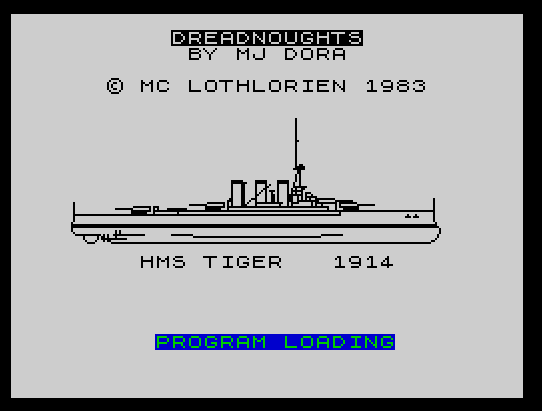
As a child, I was deeply fascinated by the First World War. The blend of modernity and archaism, the rapid evolution of new technologies and tactics, and the eerieness of trench warfare in France or mine warfare in the Alps, contrasted with the daring individual exploits in the air and the drama of early submarine warfare – captured my imagination. The world of 1914 was distant enough to be conceived as epic fiction, yet its inhabitants were close enough to me that I felt I could understand their thought process as they saw their personal and collective world collapse, better anyway than I could of the one of a Napoleonic grognard. I had to know everything, down to the smallest trivia.
Later in life, my interests capillarised from WWI to post-war Eastern Europe and more generally to the broader social, cultural, and civilizational impacts of the war. Yet, my initial interest in the First World War never faded. Alas, games about WWI are rare now and were even rarer in the 80s. Out of 120 games I have covered so far, only one (Eagles) covered this historical period – even The War of the Worlds turned out to be a more popular theme with two games. I had some hope that the arrival of British wargames would correct this somehow, and indeed I managed to find two WWI games released on ZX Spectrum, but both were multiplayer only, and I had to skip them for a time.
Today, I am back to the first of those two games, because commenter Dayyalu accepted to oppose my Battlecruiser fleet and take the helm of the German Hochseeflotte in MC Lothlorien’s Dreadnoughts.
My British fleet starts in the bottom-left corner of the map – a boring and featureless open sea. I control two pairs of armoured cruisers (1, 2) which open the way. 4 battlecruisers (6, 7, 8, 9) are screened by three large groups of destroyers (3, 4, 5). The still undetected German fleet is on the opposite side, top-right of the map.

Neither Dayyalu nor I had realized it when we started the game, but the British fleet is significantly superior to the German fleet: its battlecruisers have better guns and its destroyers are sturdier. The only advantage of the German fleet is the better armour of its battlecruisers.
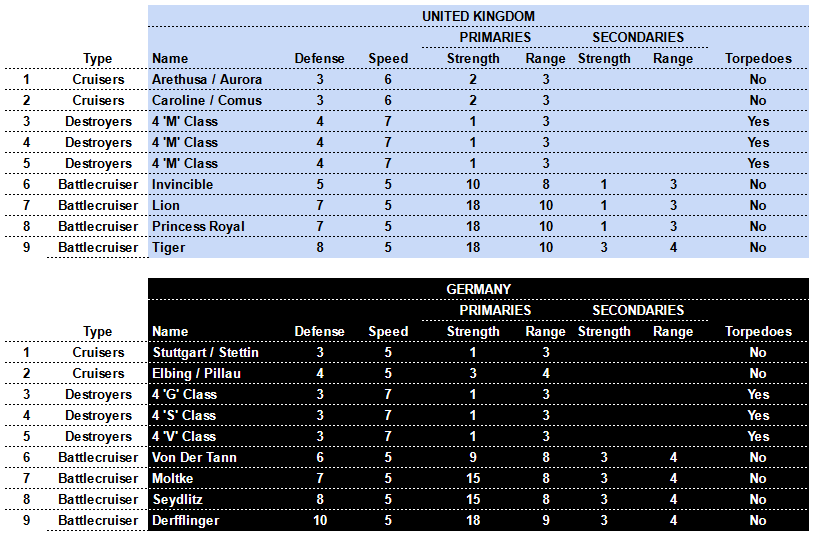
The objective for both factions is to sink 3 battlecruisers of the other side, so I could just move forward confident that Dayyalu won’t avoid battle. Still, I prefer to go for something a bit more original. If Dayyalu moves straight ahead, the first unit he will see will be the HMS Arethusa and HMS Aurora group ( #1). I will keep that group on its initial course, so Dayyalu believes I moved straight ahead, but relocate the rest of my ships to the North. With some luck, Dayyalu may, upon detecting my cruisers, pivot toward where the rest of my fleet should have been, and my destroyers may then be able to jump on his battlecruisers without having to go through a screen of smaller ships. That’s a lot of “may”, but look, I don’t have anything better for now.
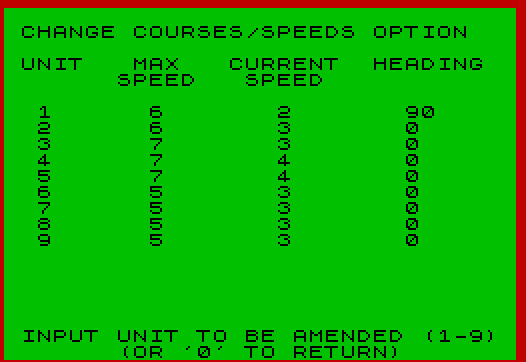
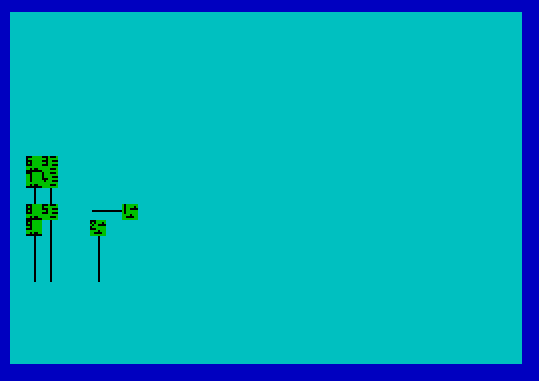
On turn 4, just after I have completed my repositioning, I see the Germans for the first time: Dayyalu has regrouped all his destroyers in one huge swarm:
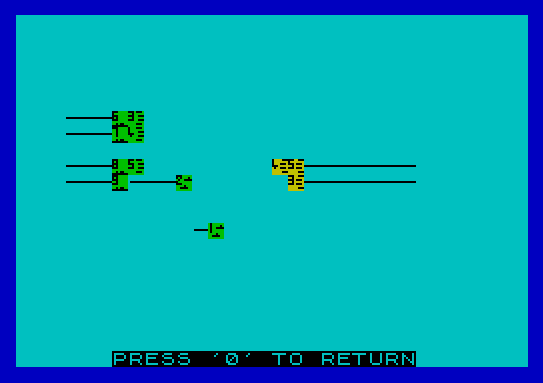
I believe he has detected my first cruiser group, and possibly my second one. I hope this means he will aim for the space between the two groups, which will allow me to obliterate his destroyers next turn while keeping my battlecruisers out of range of their torpedoes.
Alas, Dayyalu does not comply and spreads out his destroyers. Two of them end dangerously close to my battlecruisers at the beginning of turn 5.
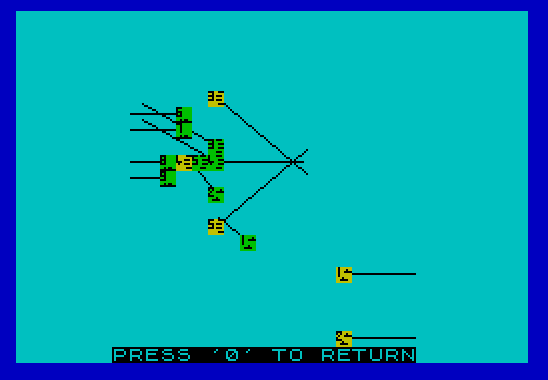
The manual states that destroyers that are sunk during turn resolution may (50% chance) be prevented from sending torpedoes, and it is not like I have anything else to do at the moment with all those guns:
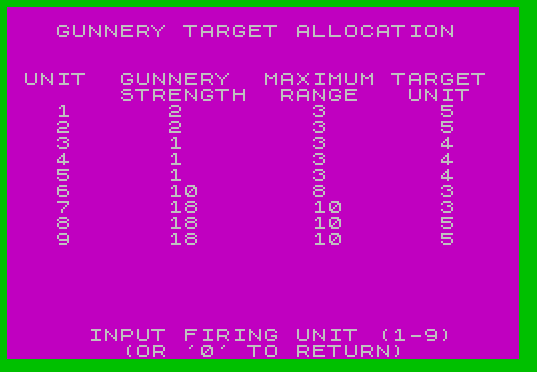
But wait! There are more guns. I should not forget the secondaries on the battlecruisers:
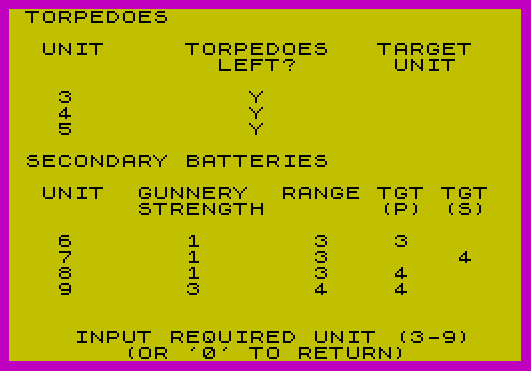
During turn 5 resolution, my battlecruisers avoid the German torpedoes, though the puny guns of the destroyers managed to damage the hull & armament of the HMS Invincible (-2 strength, -1 max speed). One of my cruiser groups was also torpedoed, but they are my least valuable asset anyway. Meanwhile, I sank one group of destroyers and presumably crippled the two others.
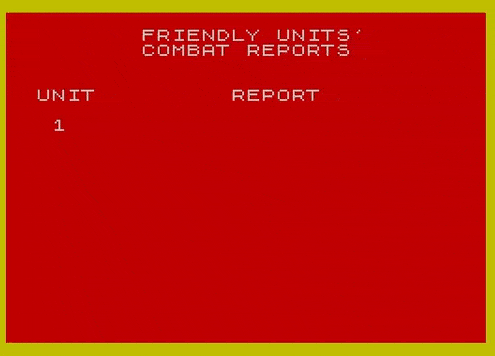
The following turn (turn 6) has extremely clear weather and I can now see 3 of the German battlecruisers. The German first cruiser group is also in range of my battleships, which don’t have a better target – the secondaries should take care of the surviving destroyers.
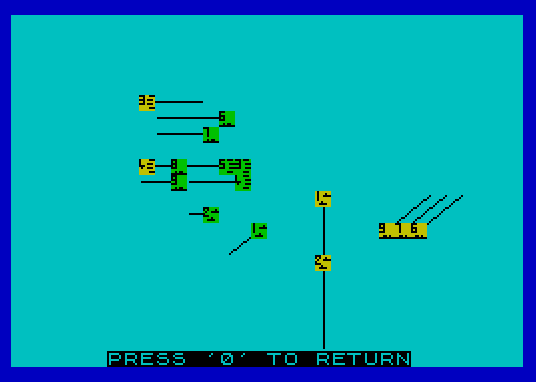
During turn resolution, Dayyalu loses two more naval assets: a group of destroyers and a group of cruisers.
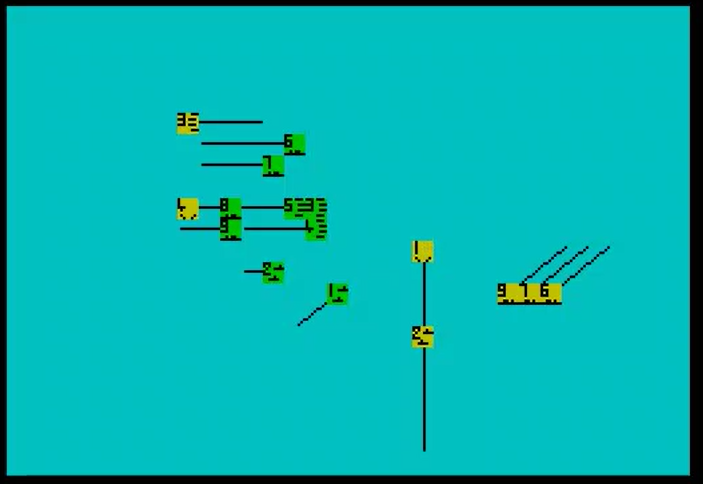
Of course, his destroyers had already launched their torpedoes and the Stuttgart & Stettin group is the worst in the game – still, my own destroyers are going to operate fairly safely.
But that’s not the best of what happened on turn 7. His battlecruisers approached, and arrived at a perfect distance: the SMS Moltke and the SMS Derfflinger are in range of three of my battlecruisers, while only the SMS Derfflinger can shoot back!
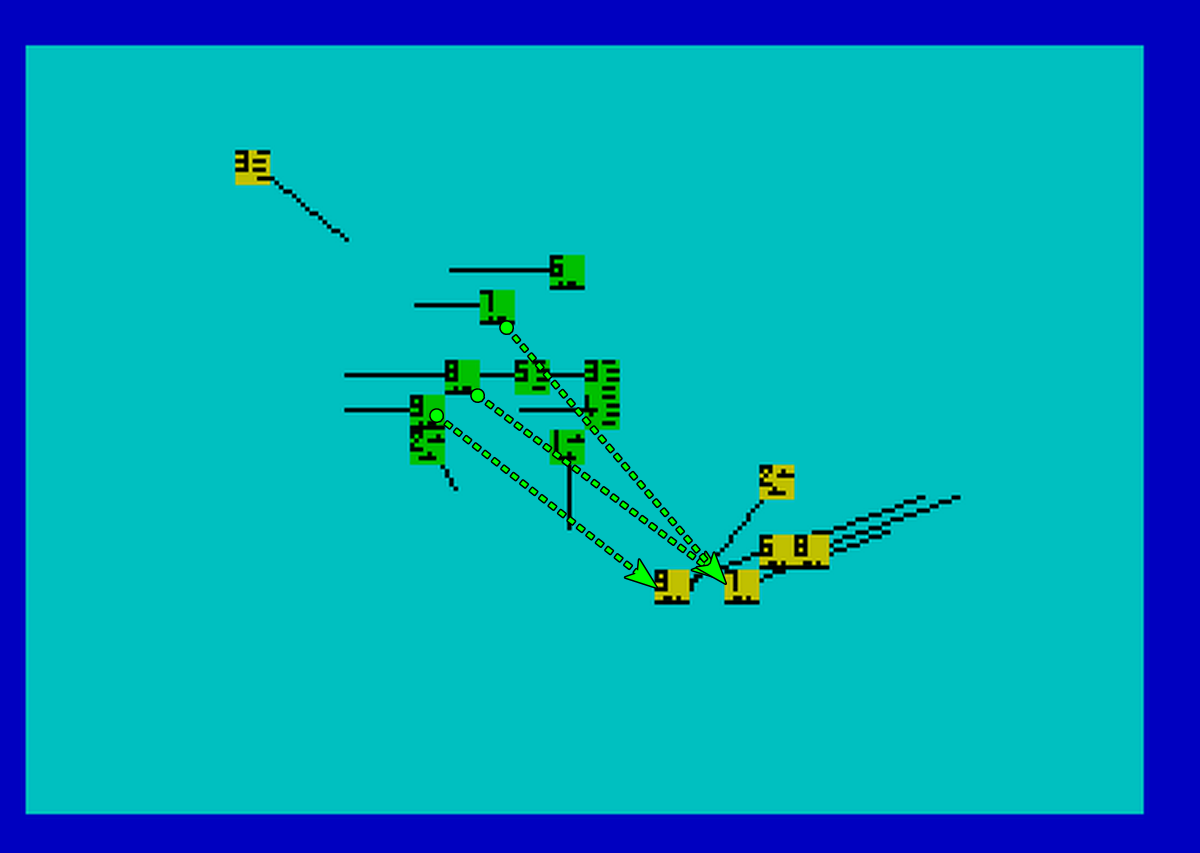
As for movement, I want to keep my distance, but I also don’t want to spread my force too much: the kind of battle line he is using seems great, so I only move a bit toward the North to regroup. I also send my destroyers where I expect him to be next turn.
When turn 8 starts, I realised I did not anticipate Dayyalu’s movement well. He headed toward me, eager as he was to close the range as soon as possible. Each of our battlecruisers can now shoot at any of the enemy battlecruisers. The manual states that if several ships shoot on the same target, then the accuracy goes down (it is hard to direct fire when your target is surrounded in splashes of water) so I decide that each of my battlecruisers will shoot at its peer. I am confident I will win this brawl, if only because all my destroyers are in torpedo range of the German flagship and are not going to let that opportunity pass!
Dayyalu meanwhile focuses all his guns on the HMS Lion. The fool! Didn’t he read the manual?
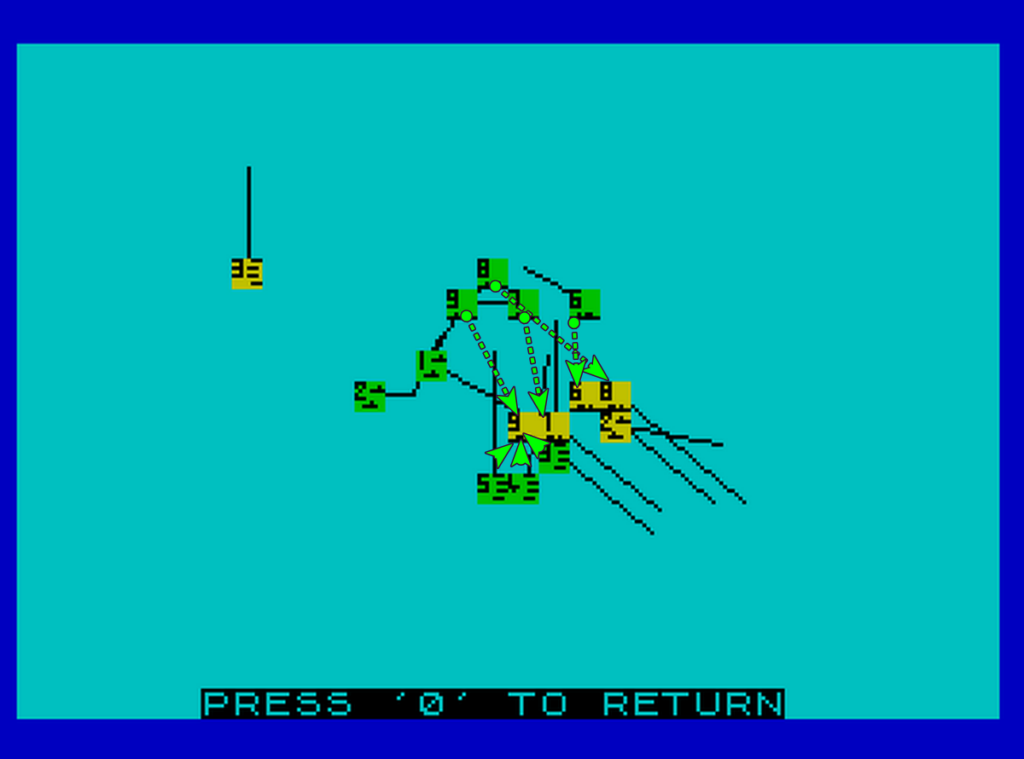
Well, maybe he was right not to pay attention to the manual, because turn 9 opens with a nasty surprise:
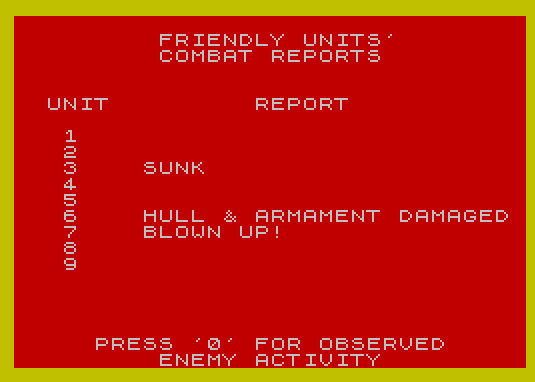
The HMS Lion just blew up, and so did the numeric advantage I had accumulated in those early turns. I also lost some of my destroyers, courtesy of the German secondary guns, but at least not before they could send some torpedoes at the SMS Derfflinger which is now dead in the water.
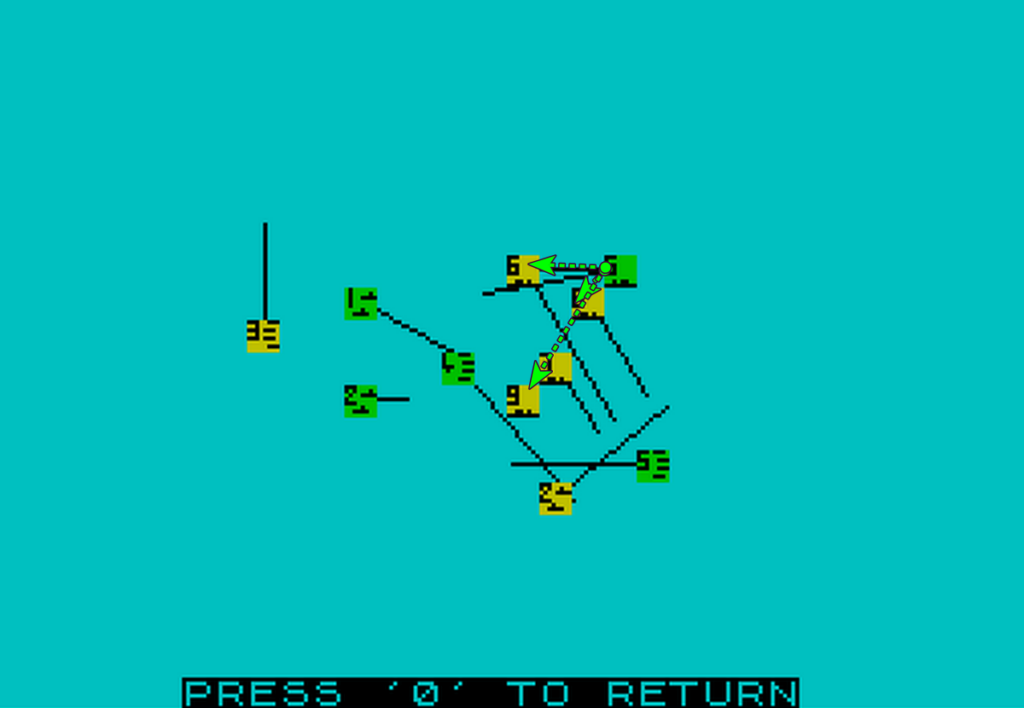
To be fair, the HMS Invincible is also dead in the water, with a max speed of 0 :
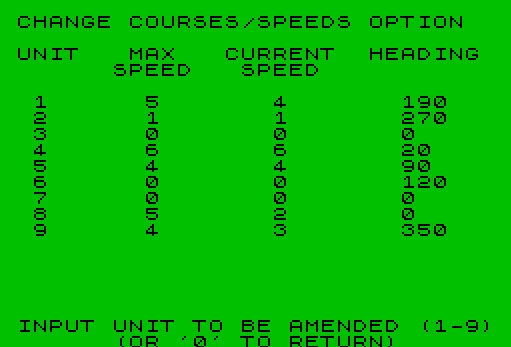
I maintain my firing order (each ship shooting at its peer), lest the game takes into account the impact of changing target on accuracy. This means that the SMS Moltke (ship #7) is not being targeted by anything else than secondaries, but so be it. I cannot conjure main guns out of thin air!
It turns out that secondaries were enough, because the SMS Moltke somehow sank during turn resolution. It had been badly hit in the initial approach, though I had no idea it was that close to sinking.
As for me, I have lost the HMS Invincible, but that was pretty much expected, and my two remaining battlecruisers are in good shape. I expect to soon be able to move out of range of the SMS Derfflinger, after that the battle will become a 2v2, I should totally win!
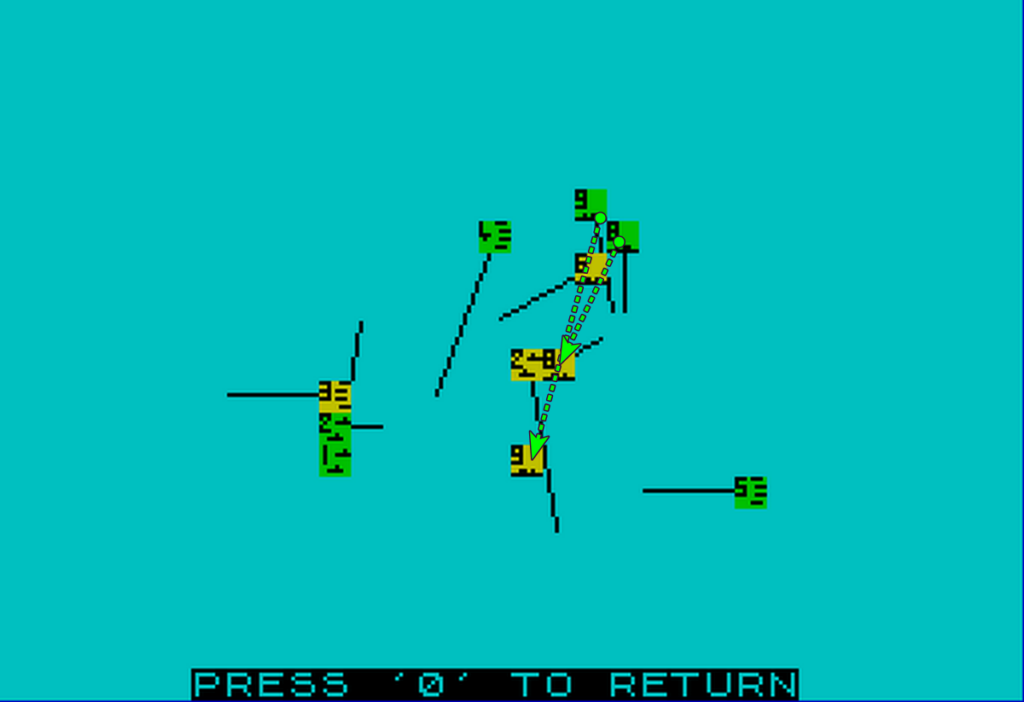
But it’s turn 10 that I make the mistake that may have cost me the battle. With 2 battlecruisers and 3 possible targets, I neglect to check the “Observed Enemy Activity” report and notice that the SMS Seydlitz (ship #8) has stopped firing. I therefore allocate the guns of my own ship #8 (the HMS Princess Royal) to her, instead of focusing on the SMS Von Der Tann. I blame tunnel vision.
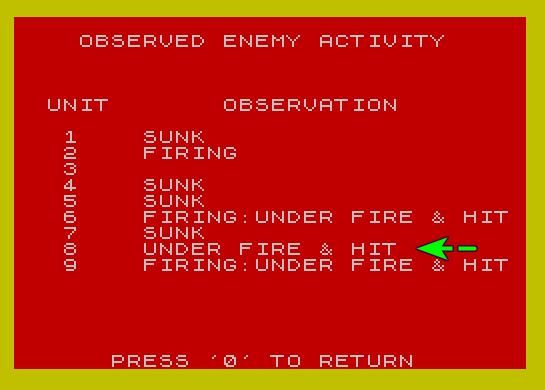
Alas I find out turn 11 that not only I did not sink any German ship, but the HMS Princess Royal was hit in the hull, and now also dead in the water, within range of the SMS Derfflinger!
There seems to be something wrong with our bloody ships today!
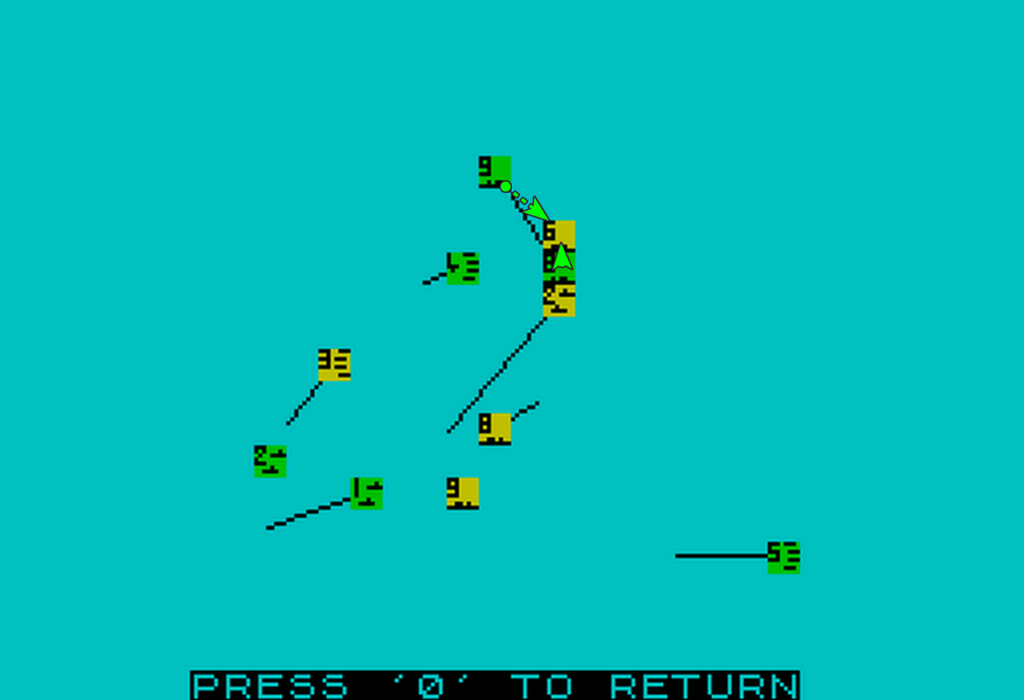
… and during turn resolution, the Princess Royal is finished off by the Germans, granting Dayyalu a victory!
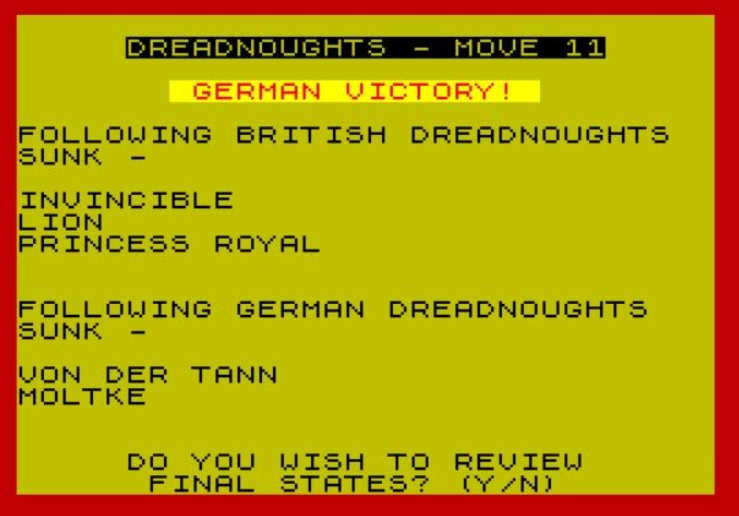
This was a close call for Dayyalu. I had sunk the SMS Von Der Tann just as I was losing the HMS Princess Royal, which means the Germans were left with one ship still moving (very slowly!) but weaponless, and one ship not moving and outranged by my surviving battlecruiser!
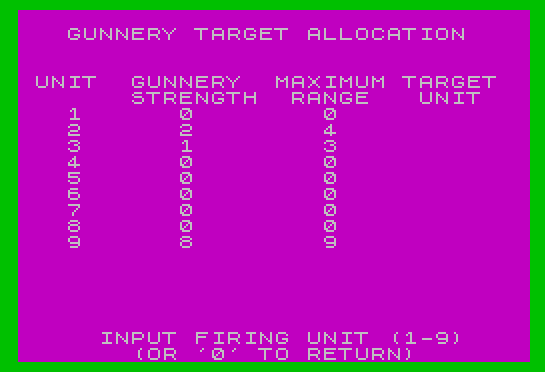
Nonetheless, I was beaten fair & square. I feel Dayyalu manoeuvred poorly early game, sending his smaller ships to battle piecemeal, but played the “target allocation” mini-game much better than I did, and big guns are what really matters in Dreadnoughts.
Ratings & Reviews
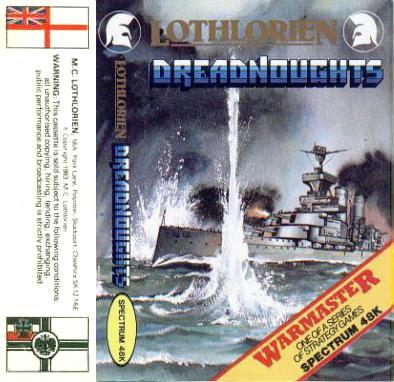
Dreadnoughts, by MJ Dora, published by MC Lothlorien, UK
Genre: Naval tactics
First release: December 1983 on ZX Spectrum
Average duration of a campaign: 10-20 turns of 3-5 minutes
Total time played: One battle
Complexity: Easy (1/5)
Final Rating: One star
Ranking at the time of review: 40/119
I could not find much information on M.J. Dora, Dreadnoughts’ author – it seems to have been his or her only game. Dreadnoughts itself is poorly documented and seems to have had a short shelf life, with most ads running from December 1983 to May 1984. It had, however, a Spanish version (El Acorazado). It is thanks to this Spanish version that I could play the game, as its manual survived whereas the English manual is lost. This means I can move directly to the review:
A. Presentation: Poor. Almost no art in the game, but at least the theme is respected, with the cruisers being almost useless and the battlecruisers doing all the work.
B. UI, Clarify of rules and outcomes: Poor. It is a bit tiresome to navigate between the various menus, and the game could have been much easier to play if it showed where you will end your movement – Dayyalu and myself both tested movements on a “blank” game, for instance to check what was the speed/angle combo necessary to move say 2 squares up and 3 squares right. I also wish there was more information in the manual on hit-chance calculation.
C Systems: Adequate. Streamlined? Yes. Imaginative? No. Does it work? Yes.
I feel the key issue with the game is the speed-to-range ratio. WWI naval battles were all about keeping a formation and remaining a specific distance from the targets. In Dreadnoughts, this is almost impossible to do: a battlecruiser can move 5 squares a turn and a destroyer 7 squares, to compare to the maximum gun range found in the game of 10.
D. Scenario design & balancing: Terrible. Open sea only, no AI, no choice in force composition. The only choice you make at the beginning of the battle is how many battlecruisers you need to sink to win, and the only variation in the scenario is on the weather, whose only impact is, I believe, the range at which the ships can see one another.
E. Did I make interesting decisions? Yes – gunnery allocation and direction mainly, though luck possibly plays a stronger role than decision-making.
F. Final rating: One star. Still enjoyable to play once, but there are better naval warfare games out there.
Reception:
SpectrumComputing only mentions three articles on Dreadnoughts:
- The first one can be found in Micro Adventurer in January 1984. It is purely descriptive, but I had to mention it because it keeps calling the game Dreadnaught, which made me chuckle,
- Big K in May 1984 reviews Dreadnoughts (“realistic, but dull to look at”) at the same time as Admiral Graf Spee. The former wins the duel by being rated “could be worse” whereas the latter is rated “could be better“; nonetheless “the ultimate naval wargame has yet to come.“
- Crash‘s review in June 1984 starts with an idiotic intro (“This strategy simulation is really an extended computer version of Battleships” – seriously?) but is still mildly positive, with a final rating of 65%, which would be terrible in a US magazine but is acceptable for a British magazine.
I suspect one of the reasons why Dreadnoughts was unpopular is that it was two-players only. True enough, I usually don’t review multiplayer games myself, but by coincidence, I have been making several exceptions recently, and there will be more soon.
7 Comments
Wait, there was a manual?
I have little to add to what the Scribe writes, bar that luck was indeed king and by focusing fire (I didn’t even know the manual existed!) I lucked out by taking one after the other the enemy ships. His return fire was murderous though, crippling me massively.
Between the insane movement speed (my screening destroyers pretty much collided with his main battleline by suprise) and the RNG this felt …. very random, a lot more “get the boys in and pray for some good rolls” than “proper evaluation of what to do”.
Also, the Germans have better armour and better secondaries: this means you’re forced to go into knife fight mode that lessens significantly any “maneuver ” shenanigans you can dream of.
Fantastico! Lovely to see the First World War in wargaming, especially dreadnoughts. We want eight and we won’t wait! Interesting ideas. I think there’s a later dreadnought game for PC, that I played around my mate Stephen Murphy’s house in Bromyard.
There’s a rather good type-in called Dreadnought on the Commodore 64 by Humphrey Walwyn, whose grandfather fought at Jutland.
So, there are no actual Dreadnoughts you can command?
To my knowledge, both battlecruisers and battleships fall into the “dreadnoughts” general category.
There are no ships of the HMS Dreadnought-class for sure.
Aren’t BCs and Dreads essentially different in developmental history? (I mean, they are both big ships with big guns but they differ extensively on role and supposed evolution, one being born of cruiser/anticruiser warfare and the other for peer engagements). One could argue BCs were born from the experience obtained from Dreads, but….
So the game technically does not have even a single Dreadnaught, from a certain point of view.
That’s my understanding as well. BC certainly were influenced by the Dreadnought principle of only having main guns of a single calibre,but as you say, role and ebolution are markedly different.
The Dreadnought label was mostly used to differentiate modern battleships from old ones who were still in use
Before settling on Battlecruiser as an official name in 1911, the Royal Navy used a few different terms among which was indeed Dreadnought Cruiser. So it’s technically not inaccurate to call them Dreadnoughts even though to be even more technical it would be somewhat anachronistic to use that term in WWI. Technicalities out.